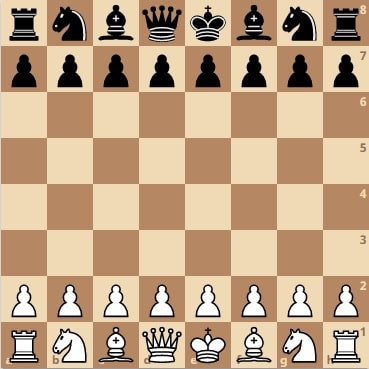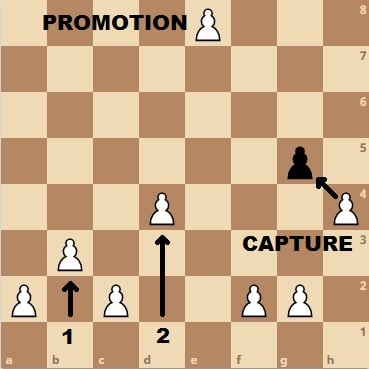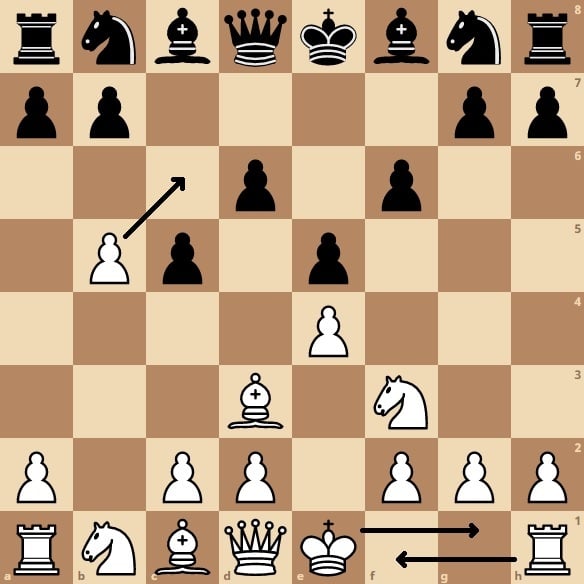In this article, I will introduce you to the basic rules of Chess and show you how to play. The object of the game is to checkmate the opponent’s King. Checkmate happens when the King is in a position to be captured (it’s in check) and cannot escape from the capture.
Setup
At the beginning of the game, the chessboard is laid out. Each player is sitting across from the other and has the white or lighter colored square in the bottom right-hand side. The chess pieces are then arranged the same way each time.
The first row should be set up as follows: (going from left to right) Rook, Knight, Bishop, King, Queen, Bishop, Knight, Rook.
The second row is filled with Pawns. You’ve set it up correctly if your Queen is on the same colored square as the color of the piece. The player with the white pieces always moves first.

A turn consists of moving one piece one time. Players alternate turns until the end of the game. Pieces may not share spaces.
Pieces cannot move through or over any other piece. Opponent’s pieces can be captured by correctly moving your piece to the square of the opponent’s piece. When a piece is captured it is eliminated and removed from the board.
Each of the six different kinds of pieces has a unique way of moving.
Chess Pieces
Pawns move one square forward towards your opponent’s side of the board at a time. Unless it is the first time it is moved during the game in which case it may be moved up to two squares forward. Pawns can only capture pieces one square diagonal in front of them. They cannot capture pieces directly in front of them but instead, are unable to move forward. If a pawn reaches the other side of the board it can be changed into any other type of piece (this is called a promotion).

Rooks can move any number of squares side to side or back and forth. Rooks cannot move diagonally and cannot jump pieces but instead capture the first enemy piece they move into. Knights move in the shape of an L moving two squares in one direction except diagonal and then one more square at a 90-degree angle.
The Knight jumps over any piece in the way capturing an opponent piece in its final move position. Bishops can move any number of squares diagonally and they capture the first enemy piece they move into. The Queen can move any number of spaces in any direction. The Queen captures the first enemy piece she moves into.

The King
The King can move one square at a time in any direction and can never be moved move into check. Whenever a move directly results in the opponent’s king being threatened meaning if an action is not taken the next turn the king would be captured the attacking player must say check.
The opponent must then use their turn to protect the King by either moving the King out of check, moving a different piece to block the path of the attacker or by capturing the piece that threatens the king. If they move directly result in the opponent’s King being threatened and there is no move to protect the King the attacking player then declares checkmate. The game is over and he wins.
A draw or stalemate occurs when the king is not in check and the player cannot legally move any of his pieces or if there is any other situation where there is an impossibility of checkmate.

Unique moves
There are a couple of other types of unique moves:
The first is called castling. On a player’s turn, he may move his king two squares over to one side and then moved the rook from the corner of that side to right next to the King on the opposite side. However, in order to castle, the following conditions must be met:
It must be the King’s very first move, it must be that rooks very first move, there cannot be any pieces in between the King in the rook and the King may not be in check nor pass through check.
The second is called en-passant. If a pawn moves out two squares on its first move, and by doing so lands on the side of an opponent’s pawn effectively jumping past the other pawns ability to capture it that other pawn has the option of capturing the first pawn as it passes by but must do so by the very next turn otherwise it loses the opportunity to capture it. The pawn must move diagonally to the square directly behind the other pawn.

The first player to checkmate their opponent wins.
My Chess Gameplay Video
In this video I played daily puzzles on chess.com in attempt to get to 1500 points. I played slowly so maybe you can try and find solution faster than me as your practice. 😉

